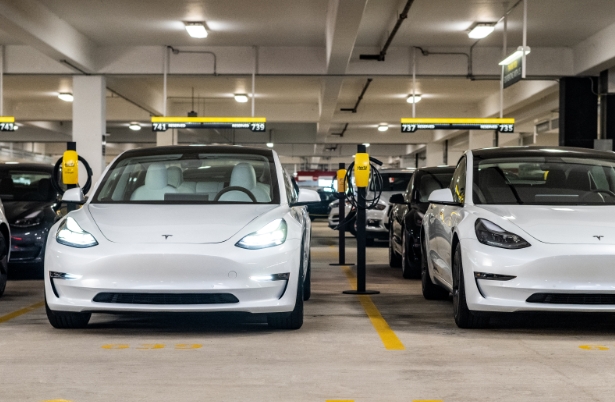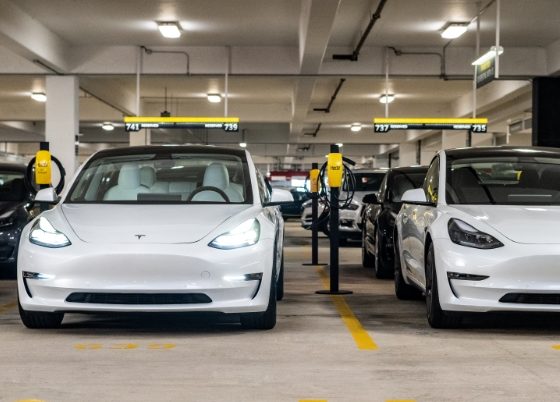Update: Lede paragraph date revised to Thursday to reflect accuracy.
Hertz gave several updates on its fleet of Tesla and Polestar all-electric vehicles, which it started offering to customers earlier this year, during its Earnings Call for Q2 2022 held on Thursday.
Hertz expanded its EV offerings to sixteen new cities earlier this month and has experienced widespread success in its EV fleet.
Initial Order of 100,000 Teslas
Hertz initially ordered 100,000 Tesla Model 3 and Model Y vehicles in October 2021. The move was Hertz’s introduction into EV adoption, which has expanded to other automakers, including Polestar, who announced a 65,000 unit deal with the rental agency just months later. The 100,000 vehicle deal was not offered at a discount. However, Hertz has maintained that its adoption of Teslas has resulted in a dramatic spike in interest from renters.
“With respect to EV specifically, over 15,000 Uber drivers to date have rented a Tesla from Hertz, at a minimum rate of $334 per week, comprising over half a million transaction days,” company CEO Stephen Scherr said. “Driver feedback has been positive and they remain drawn to the opportunity as gasoline prices remain elevated and demand for the service among Uber customers is strong. Our Tesla’s enabled Uber drivers could differentiate themselves and to improve upon the quality of their riders experience, and that translates into higher earnings for them.”
20,000 Teslas and Polestar EVs Delivered
Hertz detailed on the call that it has accepted around 20,000 electric vehicles in its fleet since it started taking deliveries of its various EVs. Scherr continued that deliveries are ongoing.
Maintenance Reductions
Electric vehicles are most often noted for their drastic reductions in service compared to combustion engine vehicles, which results in more savings over the lifespan of the car due to fewer moving parts. Hertz is learning that lesson pretty easily, according to Scherr, who stated the company is seeing a roughly 50 to 60 percent decrease in maintenance costs:
“On maintenance, I think Kenny said to you, we are running kind of 50% to 60% of what maintenance costs are on ICE vehicles. That’s roughly in line with where we are. If there’s anyone surprised, it’s probably a slightly higher expense on tires, but not much more, and that’s embedded in the figure I’m giving you. So I would say, overall, we are very pleased with the results. They’re coming in roughly in line with what we thought when we first underwrote the move in this strategic direction.”
Additionally, Kenny Cheung, Hertz’s CFO, also commented on the maintenance cost reductions:
“As for the primary drivers of the year-on-year increase, we experienced higher cost and transportation and fuel, reflecting the effect of broader inflationary trends as well as in maintenance on order fleet. We expect maintenance expenses to moderate as our fleet continues to grow younger. On the forward, we anticipate additional operating leverage as more expensive third-party labor strategically replaced with Hertz employees and we further reduced maintenance expense as we rejuvenate the fleet and continue to grow our number of EVs.”
Return Customers
Scherr said that customers seem to be more interested in renting Teslas over and over again, which has translated to an increase in repeat clients for the company. “I think we have schooled our customers on how to use them, so much so that I think there’s an embedded tether there,” he said, referring to Tesla’s key card. “They’re coming back to use the car and rent the car more frequently. And I think all of those are expressions of the first mover edge that we have around EVs.”
Consumers may be hesitant to try a new, technologically-advanced product, especially when dealing with a car. However, it seems that once Hertz’s rental clients make the jump to try an EV, they’re much more likely to come back simply because of the ease of access and features.
Less Vehicle Depreciation
Company executives also stated that the depreciation of EVs in their rental fleet is moving at a slower pace than its ICE vehicles. Cheung said that the performance of the EV fleet early on has the company “more confident” in the economics of the BEVs compared to their ICE offerings.
This is comparable to the scenario that police departments have when purchasing an EV. Initially, the cost of a quality electric vehicle is somewhat higher than an ICE vehicle. Over time, as fuel costs, maintenance, and other costs pile up, the EVs will be more advantageous to Hertz and other adoptees in the books. The cost of savings is exponentially more in an EV compared to an ICE car. This has been proven on several occasions, including with the Westport, Connecticut Police Department.
I’d love to hear from you! If you have any comments, concerns, or questions, please email me at joey@teslarati.com. You can also reach me on Twitter @KlenderJoey, or if you have news tips, you can email us at tips@teslarati.com.

Elon Musk
Elon Musk’s X will start using a Tesla-like software update strategy
The initiative seems designed to accelerate updates to the social media platform, while maintaining maximum transparency.

Elon Musk’s social media platform X will adopt a Tesla-esque approach to software updates for its algorithm.
The initiative seems designed to accelerate updates to the social media platform, while maintaining maximum transparency.
X’s updates to its updates
As per Musk in a post on X, the social media company will be making a new algorithm to determine what organic and advertising posts are recommended to users. These updates would then be repeated every four weeks.
“We will make the new 𝕏 algorithm, including all code used to determine what organic and advertising posts are recommended to users, open source in 7 days. This will be repeated every 4 weeks, with comprehensive developer notes, to help you understand what changed,” Musk wrote in his post.
The initiative somewhat mirrors Tesla’s over-the-air update model, where vehicle software is regularly refined and pushed to users with detailed release notes. This should allow users to better understand the details of X’s every update and foster a healthy feedback loop for the social media platform.
xAI and X
X, formerly Twitter, has been acquired by Elon Musk’s artificial intelligence startup, xAI last year. Since then, xAI has seen a rapid rise in valuation. Following the company’s the company’s upsized $20 billion Series E funding round, estimates now suggest that xAI is worth tens about $230 to $235 billion. That’s several times larger than Tesla when Elon Musk received his controversial 2018 CEO Performance Award.
As per xAI, the Series E funding round attracted a diverse group of investors, including Valor Equity Partners, Stepstone Group, Fidelity Management & Research Company, Qatar Investment Authority, MGX, and Baron Capital Group, among others. Strategic partners NVIDIA and Cisco Investments also continued support for building the world’s largest GPU clusters.
News
Tesla FSD Supervised wins MotorTrend’s Best Driver Assistance Award
The decision marks a notable reversal for the publication from prior years, with judges citing major real-world improvements that pushed Tesla’s latest FSD software ahead of every competing ADAS system.

Tesla’s Full Self-Driving (Supervised) system has been named the best driver-assistance technology on the market, earning top honors at the 2026 MotorTrend Best Tech Awards.
The decision marks a notable reversal for the publication from prior years, with judges citing major real-world improvements that pushed Tesla’s latest FSD software ahead of every competing ADAS system. And it wasn’t even close.
MotorTrend reverses course
MotorTrend awarded Tesla FSD (Supervised) its 2026 Best Tech Driver Assistance title after extensive testing of the latest v14 software. The publication acknowledged that it had previously criticized earlier versions of FSD for erratic behavior and near-miss incidents, ultimately favoring rivals such as GM’s Super Cruise in earlier evaluations.
According to MotorTrend, the newest iteration of FSD resolved many of those shortcomings. Testers said v14 showed far smoother behavior in complex urban scenarios, including unprotected left turns, traffic circles, emergency vehicles, and dense city streets. While the system still requires constant driver supervision, judges concluded that no other advanced driver-assistance system currently matches its breadth of capability.
Unlike rival systems that rely on combinations of cameras, radar, lidar, and mapped highways, Tesla’s FSD operates using a camera-only approach and is capable of driving on city streets, rural roads, and freeways. MotorTrend stated that pure utility, the ability to handle nearly all road types, ultimately separated FSD from competitors like Ford BlueCruise, GM Super Cruise, and BMW’s Highway Assistant.
High cost and high capability
MotorTrend also addressed FSD’s pricing, which remains significantly higher than rival systems. Tesla currently charges $8,000 for a one-time purchase or $99 per month for a subscription, compared with far lower upfront and subscription costs from other automakers. The publication noted that the premium is justified given FSD’s unmatched scope and continuous software evolution.
Safety remained a central focus of the evaluation. While testers reported collision-free operation over thousands of miles, they noted ongoing concerns around FSD’s configurable driving modes, including options that allow aggressive driving and speeds beyond posted limits. MotorTrend emphasized that, like all Level 2 systems, FSD still depends on a fully attentive human driver at all times.
Despite those caveats, the publication concluded that Tesla’s rapid software progress fundamentally reshaped the competitive landscape. For drivers seeking the most capable hands-on driver-assistance system available today, MotorTrend concluded Tesla FSD (Supervised) now stands alone at the top.
News
Elon Musk’s Grokipedia surges to 5.6M articles, almost 79% of English Wikipedia
The explosive growth marks a major milestone for the AI-powered online encyclopedia, which was launched by Elon Musk’s xAI just months ago.

Elon Musk’s Grokipedia has grown to an impressive 5,615,201 articles as of today, closing in on 79% of the English Wikipedia’s current total of 7,119,376 articles.
The explosive growth marks a major milestone for the AI-powered online encyclopedia, which was launched by Elon Musk’s xAI just months ago. Needless to say, it would only be a matter of time before Grokipedia exceeds English Wikipedia in sheer volume.
Grokipedia’s rapid growth
xAI’s vision for Grokipedia emphasizes neutrality, while Grok’s reasoning capabilities allow for fast drafting and fact-checking. When Elon Musk announced the initiative in late September 2025, he noted that Grokipedia would be an improvement to Wikipedia because it would be designed to avoid bias.
At the time, Musk noted that Grokipedia “is a necessary step towards the xAI goal of understanding the Universe.”
Grokipedia was launched in late October, and while xAI was careful to list it only as Version 0.1 at the time, the online encyclopedia immediately earned praise. Wikipedia co-founder Larry Sanger highlighted the project’s innovative approach, noting how it leverages AI to fill knowledge gaps and enable rapid updates. Netizens also observed how Grokipedia tends to present articles in a more objective manner compared to Wikipedia, which is edited by humans.
Elon Musk’s ambitious plans
With 5,615,201 total articles, Grokipedia has now grown to almost 79% of English Wikipedia’s article base. This is incredibly quick, though Grokipedia remains text-only for now. xAI, for its part, has now updated the online encyclopedia’s iteration to v0.2.
Elon Musk has shared bold ideas for Grokipedia, including sending a record of the entire knowledge base to space as part of xAI’s mission to preserve and expand human understanding. At some point, Musk stated that Grokipedia will be renamed to Encyclopedia Galactica, and it will be sent to the cosmos.
“When Grokipedia is good enough (long way to go), we will change the name to Encyclopedia Galactica. It will be an open source distillation of all knowledge, including audio, images and video. Join xAI to help build the sci-fi version of the Library of Alexandria!” Musk wrote, adding in a later post that “Copies will be etched in stone and sent to the Moon, Mars and beyond. This time, it will not be lost.”










